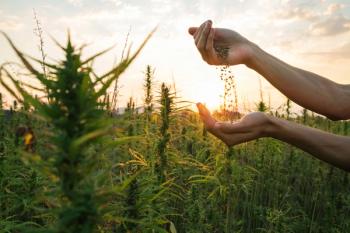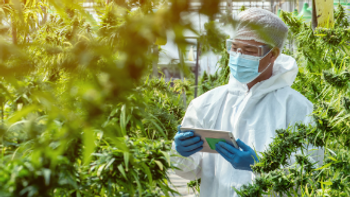
Cannabis Science and Technology
- January/February 2022
- Volume 5
- Issue 1
- Pages: 30-31
Get Help Greening Your Grow Utility Efficiency Programs Supporting Cannabis Cultivators

Learn about the diverse kinds of support cannabis growers can get from utilities and efficiency programs for efficient lighting, heating, ventilation, and air conditioning (HVAC), and controls approaches.
In the US there are hundreds of efficiency programs specialized to support cultivation operations and enable operators to install high-performance building systems and equipment with lower first costs. Understand the ways indoor cultivators and greenhouse growers alike can get technical assistance and financial support for efficient equipment. Learn how you can plan capital projects while engaging with efficiency programs to maximize incentives for high-performance technologies and strategies.
Understand the Ways Programs Support Cultivators
Cannabis cultivators across the United States and Canada can receive free support from energy efficiency programs. Energy efficiency programs are sometimes housed within an energy supplier as part of a utility or, in other cases, are administered by third parties called implementers.
Efficiency programs spend ratepayer money to improve resilience and affordability of energy supply and efficiency, and to align with state policy goals such as greenhouse gas emissions reductions. Program offerings include technical assistance and financial incentives for energy efficiency projects.
Technical assistance can include energy education, design guidance, energy modeling, and review of equipment choices. Financial incentives on efficient technologies can vary dramatically from one market to the next, and their support can drastically affect payback periods of efficiency projects (1).
Resource Innovation Institute (RII) is a non-profit organization committed to cultivating a better future for all of humanity. Our consortium of members brings perspectives from across the field—uniting architects and engineers, growers and operators, researchers and analysts. Together, we measure, verify, and celebrate the world’s most efficient agricultural ideas. In this article, RII’s Technical Director and members of the organization’s
Learn What Efficiency Technology Is Eligible
Programs helping cannabis cultivators have historically incentivized efficient lighting and heating, ventilation, and air conditioning (HVAC) equipment for indoor and greenhouse facilities (4). RII Technical Advisory Council member Evergreen Consulting Group serves utilities and energy organizations across the country by working across the entire supply chain of market sectors including efficient technology manufacturers, installers, utilities, and their customers to ensure the best energy choices are available and being utilized.
In the cultivation market, Evergreen has been supporting horticultural lighting projects in Oregon since 2017. The cannabis industry started incorporating high-performance lighting technology once high market supply began compressing wholesale prices and driving facility efficiency. “Now we’re on the forefront of working with light emitting diode (LED) solutions that can be tuned to maximize growth for the needs of different crops at all growth stages. Programs help design efficient lighting solutions that also maximize yield,” said Lauren Morlino, Technical Manager at Evergreen.
Efficiency programs in dozens of states are specialized to work with horticultural facility operators. It can be very valuable to have a designated controlled environment agriculture (CEA) program as the cannabis market uses unique technology. Evergreen has program specialists and technical experts to help utilities implement these complex custom incentives. “Growers really appreciate when you have specialists on staff who can help growers’ crops thrive indoors, without sacrificing efficiency,” said Morlino. “We can help growers holistically by supporting more technologies than just what is found in the cultivation space. Utilities have started to provide incentives for equipment used in drying, curing, refrigerated storage, and extraction laboratories.”
Get Valuable Assistance
In many states, growers can receive comprehensive design services for free or at a discount from efficiency programs. Programs offer this service so that the utilities can help assess facilities for potential grid impacts and efficiency opportunities. Some utilities and efficiency programs use benchmarking tools like PowerScore to create performance snapshots of facilities during design to estimate key performance indicators and inform equipment selection (5). As you work with efficiency program partners, engage qualified and credentialed engineers and technology specialists such as mechanical designers or lighting manufacturers who provide layouts, specification sheets, and sizing for equipment.
Some CEA implementation experts like Evergreen work hand-in-hand with utilities to bring in subject matter experts and help growers with complicated aspects of cultivation operations. In some locations—for example, Utah and Michigan—Evergreen is involved early in the new construction process. Close interaction with the growers through incentive programs and technical assistance lead to better planning and outcomes for both the grower and the utility. “We have seen in several states, like Utah, that using HID fixtures would have required the utility company to make a cost-prohibitive service upgrade at the customer’s expense. When energy efficiency programs are involved early, customers can receive incentives for LEDs and, at the same time, avoid those additional start-up costs like grid infrastructure upgrades. All parties benefit,” said Morlino.
Maximize Incentives
Grow facilities are complex buildings. Utilities often need detailed technical information about your facility and operation to adequately estimate potential energy savings and calculate incentives. To achieve the greatest financial support for high-performance equipment such as LED lighting and integrated controls, document what you know about your facility and capital projects so program staff can assess operational efficiency and offer projections of financial support early in project planning. Your design team members can work with your program partners to provide project details and ensure energy data is accurately collected and used during the incentive process.
Receiving incentives can be a breeze when you work effectively with utilities and efficiency program staff. Efficiency program implementers like Evergreen specialize in processing incentive paperwork, coordinating with contractors, and issuing incentives so the facility operators can focus on making a profit.
Tips for Working with Utilities
As you plan your new construction or retrofit project in your indoor grow or greenhouse facility, take advantage of the free services and financial programs available from your electric and gas utilities and the efficiency programs implemented in your region. Consider these tips as you get help maximizing technical assistance and financial incentives:
- Engage utility and efficiency program teams early.
- Take advantage of free assistance during the design phase.
- Maximize incentives for efficient equipment and controls.
- Gather your project information to ensure timely incentives.
- Benchmark a typical year of facility performance to understand potential environmental and business impacts of energy consumption.
- Ask utilities about their rates to understand which are available for your facility based on expected usage and demand.
- Work with your utility to understand how you can reduce peak demand during certain times of the day for additional savings.
- Continue to benchmark and share performance data to unlock additional incentives for efficiency and productivity improvements.
Download RII’s new free
References
https://catalog.resourceinnovation.org/item/controlled-environment-agriculture-market-characterization-report-433708 .https://resourceinnovation.org/tac/ .https://catalog.resourceinnovation.org/item/program-design-market-engagement-primer-407538 .https://catalog.resourceinnovation.org/item/program-design-market-engagement-primer-407538 .https://powerscore.resourceinnovation.org/go-pro .https://catalog.resourceinnovation.org/item/best-practices-guide-automation-controls-cannabis-cultivation-435539 .https://www.cannabissciencetech.com/authors/gretchen-schimelpfenig .
About the Columnist
Gretchen Schimelpfenig, PE, As Technical & Operations Director, Gretchen manages the PowerScore resource benchmarking platform, facilitates RII’s Technical Advisory Council Working Groups, and manages RII’s continuing education program for producers, efficiency programs, and design and construction communities. She works with members and subject matter experts to publish technical guidance for the production of plants in controlled environments, develops and delivers curriculum, and supports PowerScore users with resource benchmarking analysis and reporting compliance. She authors RII’s Best Practices Guides for controlled environment agriculture.
Gretchen is a licensed Civil Professional Engineer (Construction) in California and Vermont. She also has a specialty in analyzing the interactive effects between HVAC and lighting systems and commissioning controls systems. Gretchen grows vine crops, cannabis, and herbs in her veggie garden, greenhouse, and basement in her Vermont farmhouse and is constantly using her HVAC and lighting knowledge to optimize her grow environment.
About the Guest Co-Author
Lauren Morlino is a Technical Manager at Evergreen Consulting Group. Lauren specializes in researching and prototyping exciting, innovative, and efficient technologies and services for customers, especially controlled environment agriculture (CEA) and underserved communities. During her career in the energy efficiency industry, Lauren has researched and designed initiatives for lighting, controls, refrigeration, consumer electronics, and CEA equipment. She has consulted across the U.S. on customer-centric program design and CEA, and has published papers on several emerging technologies. Lauren has presented at national conferences including ACEEE, AESP, DesignLights Consortium, DOE Better Buildings Summit, HortiCann Light +Tech, Indoor Agriculture Energy Solutions, Esource, NEEA Efficiency Exchange, and NEEP.
How to Cite this Article
G. Schimelpfenig and L. Morlino, Cannabis Science and Technology 5(1), 30-31 (2022).
Articles in this issue
almost 4 years ago
In Search of the Golden Potency Methodalmost 4 years ago
How Are Tetrahydrocannabinol—THC—Isomers Entering the Market?almost 4 years ago
Cannabis Research Is Cannabis Sciencealmost 4 years ago
Autoflowering Genetics Present Unique Opportunitiesalmost 4 years ago
Mycology 101: Understanding Mold as a Threat in the Cannabis Industryalmost 4 years ago
How Does Carbon Dioxide Enrichment Affect Environmental Control?Newsletter
Unlock the latest breakthroughs in cannabis science—subscribe now to get expert insights, research, and industry updates delivered to your inbox.



